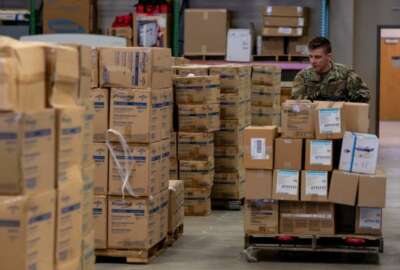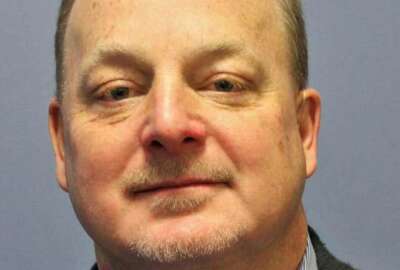
Meet the guy who makes sure FEMA arrives at a disaster fully prepared
Behind the visible efforts though FEMA, there is a mission support function that ensures the right money, equipment and people are in place.
Best listening experience is on Chrome, Firefox or Safari. Subscribe to Federal Drive’s daily audio interviews on Apple Podcasts or PodcastOne.
When disaster occurs, the Federal Emergency Management Agency is often the most visible presence. Behind the visible efforts though, FEMA has a mission support function that ensures the right money, equipment and people are in place. That work is supervised by our next guest, Eric Leckey, an associate FEMA administrator for mission support and a newly named fellow of the National Academy of Public Administration. He joined the Federal Drive with Tom Temin.
Interview transcript:
Tom Temin: And I’m reading from your bio, that you provide leadership and direction to achieve business excellence to a team of 1477 mission support professionals, another 603 disaster reservists delivering a $504.3 million program of requirements in the areas of administrative and real property services, et cetera, et cetera. What do you actually do there? As deputy administrator?
Eric Leckey: Yeah, Tom, we are essentially the backbone of the agency. We provide all the business administrative services to achieve business excellence here at FEMA, in support of the mission. This is your typical human capital work, your procurement, buying of products and services, IT and cybersecurity facilities, safety and health, psychological support services, security, and so on. It’s the machine that keeps the agency running in the background to ensure that we’re able to provide the services to disaster survivors in their time of need.
Tom Temin: And I imagine one of the most difficult challenges you have is predicting requirements, needs for a given year, because you have no idea how much FEMA will have to respond.
Eric Leckey: Yeah, Tom, that’s absolutely right. And so it’s very critical that we’re at the table at all times in the planning phase in advance of any activity, so that we’re able to project and to plan alongside of our operational partners, what the needs will be in buying through our advanced disaster contracts and ensuring that we’ve got a forward leaning human capital posture to support not just our steady state, but our local hiring, to ensure that our IT and other mission enablers are in place to allow our partners as well as our agency to assist disaster survivors when they need it, which is not always predictable. It’s not always something that we know it’s going to happen when it’s going to happen. So we’ve got to be there and be at the ready alongside of our operational partners.
Tom Temin: And in providing appropriated funds, do you find that Congress allows FEMA to have a certain contingency level of funding, which is not something they generally like to have with agencies, but with FEMA, it seems almost like a necessity.
Eric Leckey: Yeah, it is a necessity. And I’ll state from the front that we maintain a good relationship with our appropriators, as well as our oversight committees in Congress, as well as OMB so that we’re constantly managing our resources to ensure that we’ve got what we need when we need it. And that as additional disasters occur in any particular given season, we’re prepared with the resources we need at the forefront. And that that doesn’t become an obstacle and a response or certainly a long term recovery.
Tom Temin: And just a detail question; a lot of federal agencies detail people to help out FEMA for the duration of a disaster presents, are those people paid by their home agencies? Are does FEMA have to temporarily take them on the payroll?
Eric Leckey: Well, it depends on the arrangement. And you’re absolutely right, whether it’s the surge capacity force across the Department of Homeland Security, or other inner agency agreements with other federal partners and agencies, or whether it’s through our emergency management exchange programs, where we send our professionals to the states or the states and their professionals to FEMA, we work out the arrangement on who is paying what piece of the bill as part of that process. Certainly, we do do reimbursables. That is part of our structure. But it really does depend on the function. It depends on the purpose and why we’re doing what we’re doing that will ultimately determine from where we pay the bill.
Tom Temin: And just briefly describe the strategy for stockpiling supplies versus buying what is needed for a particular situation because stockpiles have a way of turning up no good anymore by the time you sometimes open the closet.
Eric Leckey: Yeah, no, we do both. We certainly make sure that we’ve got our logistics warehouses strategically positioned across the United States in our territories, so that we’ve got what we need when we need it from food, water all the way down to blue sheeting for roof work. But we also do on-demand buy we maintain steady advance contracts. We’re constantly in touch with our vendors and our suppliers so that we understand what the supply chain looks like, not just in terms of their ability to manufacture and produce, but our ability to get it in the logistics network and on the ground where we need it.
Tom Temin: We are speaking with Eric Leckey. He is associate administrator for mission support at FEMA and a new NAPA fellow and let’s talk about you a little bit since you are a NAPA fellow, tell us about briefly your career and you’re a senior executive service member. What’s it like working kind of in the background for an agency that’s often so highly visible, with the administrator standing in the wind with a microphone and blue tarp in the background and all of that?
Eric Leckey: Tom, it’s a privilege, let me say that to work at FEMA, and to be part of this mission where we help people in their most critical time of need is a high honor. I have been working in and for or as a primarily client, in the Department of Homeland Security for the last 20 years. I came to Washington shortly after 911, I was very intrigued by the idea of Homeland Security, started off at the Office of Homeland Security, and then the Homeland Security Council at the White House before then going to work for the Secretary of Homeland Security. And my career has really gone on since then. I’ve been with FEMA since 2011. I’ve enjoyed every minute of it first as the chief privacy officer here for a number of years, then as the deputy chief administrative officer, and then deputy associate now associate administrator. So largely, the management administration functions of the agency, ensuring that we’re providing what our partners and our stakeholders need, those who we consider our customers here at the agency and in the interagency community to be successful in our operations.
Tom Temin: I was gonna say there’s a big interagency cooperative element to what you do. So in some sense, you’re a diplomat.
Eric Leckey: Very much. So interagency partnerships, our partnerships with our state, local, tribal and territorial partners is critical to what we do. We certainly bring people to the mission, we bring money, we bring capability. But those partnerships are absolutely critical and pivotal, and all that we do.
Tom Temin: Those and also the contractual arrangements with industry, because, yes, there’s a legal contractual element to it. But there’s also a partnership element to it for the reality of dealing isn’t there?
Eric Leckey: Tremendous partnership, we couldn’t do it without the private sector. We have a national business emergency operations center here that operates within our office of response and recovery. And we’re forward leaning 365 days with those partners and those vendors and those private sector enablers just as we are with our state, local, tribal and territorial partners, you’re right, we couldn’t do it without them. We know that, they know that. Our relationship reflects that. And we spend a great deal of time in the background year round not just managing those relationships, but nurturing them, making sure that they are with us in our thinking on where we’re going and what we need to do so that when we reach the point in time, when we need to do it, sometimes with little to no notice. They’re prepared, we’re prepared and we can execute on behalf of the American people.
Tom Temin: So really supply chain and logistics challenges that the country might be going through at a given moment are also FEMA challenges then?
Eric Leckey: They are. They’re absolutely FEMA challenges. And they’re things that we have to work through, no matter what the supply chain network looks like, no matter what the available commodity situation looks like. It’s our job to work with our partners to find them, and to get them where we need them to be. But that’s not always easy. We saw that during the COVID response, where we got into a pandemic very quickly. And we had a very critical need to get resources fast. And I think that’s where FEMA brought its strength to the table along with our federal and state partners.
Tom Temin: And do you ever get a chance to get out into the field and just see all of the back office and planning work in action?
Eric Leckey: I do. Tom I just spent a couple of weeks ago, three or four days in Florida, the Fort Myers area after Ian, I try to make that a point after every major storm to get on the ground to make sure that our team has what they need, that we’re delivering to our customers in the way that they expect us to. As an agency, we’re only as strong as our weakest link. So it’s got to be all hands on deck at a time like that. And I consider myself to be part of that.
Tom Temin: Now you are a fellow of the National Academy of Public Administration. What do you plan there? Do you have any assignments yet? We’ll be your area do you think of contribution there?
Eric Leckey: I’m really excited about this opportunity to contribute to the future of public administration. The grand challenges of public administration really do lay out a vision for the future and where we as a profession need to go. In fact, I was just inducted last week. I’ve just started with the organization in this collateral duty. I plan to work on a number of different assignments and opportunities. I can see a future potential in the profession of public administration and outlining the future and the path there all the way down to some of the specific initiatives underway as it relates to resilience in communities and ensuring that they have and are planning for what is very clearly an evolving climate situation that everyone needs to be prepared for.
Tom Temin: Eric Leckey is associate administrator for mission support at FEMA and a new NAPA fellow.
Copyright © 2025 Federal News Network. All rights reserved. This website is not intended for users located within the European Economic Area.
Tom Temin is host of the Federal Drive and has been providing insight on federal technology and management issues for more than 30 years.
Follow @tteminWFED
Related Stories




